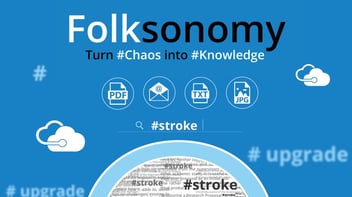In this webinar, our CIO and Dr. Sans explain Bismart's Folksonomy project implemented at Hospital del Mar.
On June 3, our Director of Innovation, Ismael Vallvé, with the collaboration of Dr. Laia Sans from the Nephrology Department of the Hospital del Mar, offered the webinar Folksonomy Text Analytics. During the training, Ismael introduced the concept of folksonomy and the Bismart Folksonomy tool and Dr. Laia explained the project carried out in her hospital with this technology in collaboration with the pharmaceutical company Ferrer.
If you want to watch the training again or if you missed it, you can do so here:
Folksonomy is a concept based on taxonomy, which is nothing more than the art of classifying by means of labels. The word folksonomy comes from taxonomy, but also from folk, which means 'people'. Thus, folksonomy means social labeling. This concept was born in the 1990s thanks to bookmarking portals such as Delicious.
One of the main advantages of folksonomy is that it allows working with unstructured data. Until recently, the only information that could be used to carry out data analysis was information structured in fields, i.e. information that had been prepared for computers to process. On the other hand, information in the form of text, audio, etc. could not be processed in this way, but had to be processed manually. The problem is that, according to the consulting firm Gartner, 95% of the value of the information is in this unstructured data.
One of the major advances in the analysis of unstructured data is the usage of Large Language Model (LLM). This model is based on the use of artificial intelligence to analyse large amounts of information in real time. The advantage of this model is that it allows the understanding of natural language, which makes it possible to identify patterns and trends in the data. The combination of LLM and folksonomy can be a powerful tool for the analysis of unstructured data in healthcare and clinical research, as it allows a deep understanding of the natural language used in these fields. Furthermore, the automation of the master entity creation process by folksonomy allows for faster and more efficient data analysis, which can be especially useful in clinical situations that require real-time decision making. In summary, the combination of LLM and folksonomy can be a valuable tool for research and clinical practice.
Until now, in order to analyze this unstructured information, a master entity had to be created to classify the information within the text. The problem is that these types of entities must be created manually and are very large tasks, so there can often be errors or the entity may not contain all the valuable information found in the data. In the end, in many cases the creation of the master entity is more work than analyzing the documents manually.
Another advantage of Folksonomy is that it does not require this master entity because it analyzes all documents in parallel based on weighting rules according to the grammatical category of the word, which automatically brings up the most relevant terms. This way the master entity is formed automatically. This way of working is called bottom-up, while manual entity creation is called top-down. Working in a bottom-up way also enables data-discovery, which means that relevant terms that we did not know were there, can be discovered in the data, but they would not have appeared in the master entity if it had been created manually. The same applies in reverse, in a master entity created by Folksonomy concepts that are not in the documents will not appear.
In the healthcare field, the capabilities that doctors have reported about Folksonomy are that it allows them to understand clinical practice and its variability, it provides real-time decision support, determines the epidemiology of the population, generates clinical research hypotheses, conducts observational studies and predicts clinical cases before they occur, among others.
After Ismael's explanation, which he ended with some practical examples, Dr. Sans presented Hospital del Mar's experience with folksonomy through her article Big Data: Application of Folksonomy for Clinical Nephrology Research.
This training is part of a series of weekly webinars. Subscribe to our blog and Youtube channel to watch the previous ones and not miss the next ones.

